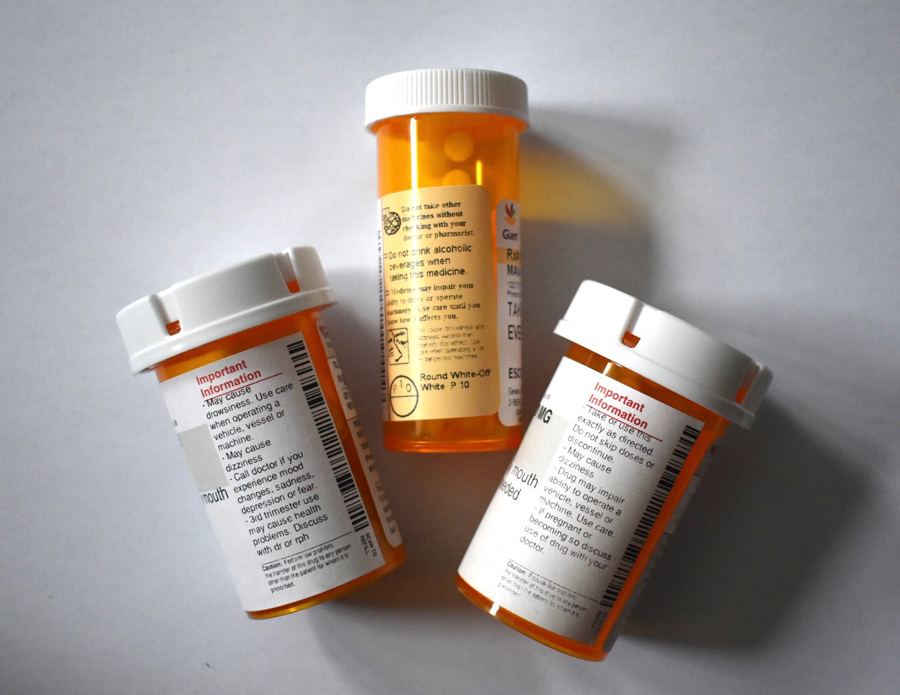‘We see real miracles here’: local groups tackle opioid addiction
Maia Spoto/The Daily Northwestern
Prescription pill bottles. In Evanston, PEER Services treats patients for opioid addiction, often using methadone, itself an opioid.
January 23, 2020
For the 160 or so patients receiving medication-assisted treatment for opioid addiction in Evanston, curbing dependence has become part of their daily routine.
Every day, these patients go to the Davis Street substance abuse treatment center PEER Services, where nurses dispense methadone, a prescribed oral medication that minimizes withdrawal symptoms and reduces cravings. Because these patients require long-term, controlled doses of methadone — which is also an opioid — most of them will return to PEER Services every day.
“It’s an incredibly painful withdrawal experience,” said Erin Tegge, PEER Services’ prevention program coordinator. “It is absolutely horrible for the person going through it. That’s where the methadone comes in — it’s able to manage those withdrawal symptoms so that the person can actually function in their daily life.”
Opioid addiction poses a particularly potent threat to the Chicago area. More people died from fentanyl overdoses than homicides in Cook County in 2019, according to the Cook County Medical Examiner’s office. In the county, fentanyl toxicity killed 789 people last year, compared to 580 people killed by guns.
Paul Polep, Evanston Fire Department’s deputy chief, said overdose deaths in Evanston haven’t risen to a crisis level. Polep said there were six heroin overdoses in Evanston last year, though four were the same person. While fire department paramedics are trained to administer Narcan — a life-saving medication that can reverse an opioid overdose — he added that the department doesn’t target opioid addiction’s root causes.
“In the city of Evanston, it’s not as big of a problem as a lot of other communities,” Polep said. “Do we have heroin overdoses? We do. Do we have an epidemic in Evanston? We do not.”
Still, community organizations and addiction therapists have stepped up to treat North Shore residents, providing care and counseling for community members impacted by opioid addiction.
Therapist Tom Ross, who specializes in treating addiction, focuses on the trauma or self-esteem issues that may drive his patients’ addictions. In Evanston, while traditional causes of opioid addiction, such as genetic risk factors and easy access to prescriptions, are at play, he said opioid dependency also manifests in the area in more unique ways. The community can get competitive, he said. When people feel pressure to “keep up with the Joneses,” they may turn to opioids to cope.
“You have very rich and very poor living in the same community,” Ross said. “The people that come into my office tend to be middle- and upper-middle-class people with resources and with means, and with reputations to protect. You have parents that are very high achievers who expect a lot of their kids, which can be really daunting and really stressful.”
While PEER Services executive director Maureen McDonnell hasn’t noticed an uptick in patients in line with national trends — opioid overdose deaths were six times higher in 2017 than in 1999 — she said there’s a “steady stream” of people who seek out PEER Services’ treatment.
“It’s not at the same rate or pace that you hear about in other states with much higher per capita rates of overdose deaths,” she said. “But it isn’t uncommon either. Especially when I started here two and a half years ago, I would hear, ‘Yeah, boy, we never expected to be dealing with that here.’”
Evanston operates a medication and needle disposal service based out of the police headquarters and fire headquarters. Residents can drop off medications and needles at the fire department and medications at the police department, which remains open 24 hours a day for collection. Evanston fire department chief Brian Scott said public education on the risks of synthetic opioids may help reduce addiction in Evanston.
In addition to medication-assisted treatment, PEER Services offers a slate of programs ranging from individual outpatient treatment to group therapy to cognitive behavioral therapy. The center opens early and closes late, so patients have ample opportunity to schedule care, and offers family support and early adolescent intervention services to prevent addiction from developing early.
But for low-income people, seeking treatment can be especially challenging. Even though PEER Services doesn’t deny treatment to people without insurance, Ross said many low-income people may not be aware of existing networks, making it difficult for them to connect with resources and referrals.
As a result, many turn to federal or state programs with long waiting lists, while others forgo treatment, Ross said.
While overdose rates are easy to measure, McDonnell said the number of people in recovery is more difficult to quantify. However, this number, she said, is significant.
“A lot of people have been getting into treatment in the last few years because of the opioid epidemic and the expansion of services available,” she said. “I want people to know recovery is a real thing. We see real miracles here every day.”
Email: [email protected]
Twitter: @herscowitz
Related Stories:
Interdisciplinary research team awarded $10 million NIH grant to develop device to treat opioid overdose
U.S. Sen. Dick Durbin urges big pharma action on opioids at law school talk


